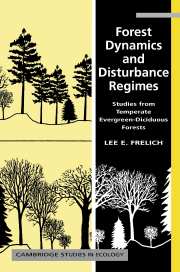Book contents
- Frontmatter
- Contents
- Preface
- Acknowledgements
- 1 The forest setting
- 2 The disturbance regime and its components
- 3 Sampling and interpretation of stand disturbance history
- 4 Disturbance, stand development, and successional trajectories
- 5 The study of disturbance and landscape structure
- 6 The disturbance regime and landscape structure
- 7 Disturbance in fragmented landscapes
- 8 Forest stability over time and space
- References
- Appendix 1
- Index
1 - The forest setting
Published online by Cambridge University Press: 11 August 2009
- Frontmatter
- Contents
- Preface
- Acknowledgements
- 1 The forest setting
- 2 The disturbance regime and its components
- 3 Sampling and interpretation of stand disturbance history
- 4 Disturbance, stand development, and successional trajectories
- 5 The study of disturbance and landscape structure
- 6 The disturbance regime and landscape structure
- 7 Disturbance in fragmented landscapes
- 8 Forest stability over time and space
- References
- Appendix 1
- Index
Summary
Introduction: disturbance in temperate conifer–hardwood forests
More than one-fourth of the world's forest land lies within the cool-to-cold temperate zones of the northern and southern hemispheres. Their distinctive mosaics of evergreen conifers and deciduous hardwood species have been shaped by fire, wind and herbivory over thousands of years. In the last few centuries human activities have increasingly changed the dynamics of these mosaics. Over much of the conifer–hardwood forest zone fire frequencies have been reduced by fire suppression and exclusion, harvesting has replaced fire as the main disturbance, global warming may be causing an increase in the frequency of high winds, and the intensity of grazing has increased.
Scientists and forest managers would like to understand how changing disturbance regimes and interactions among disturbances will influence forest successional trajectories. Managers of nature reserves would like to know what types of manipulations would restore the forest to a natural condition. The main purpose of this book is to illuminate the role of disturbances in temperate conifer–hardwood forests for these scientists and managers. Therefore, I have chosen three major themes for the book:
To show how three major disturbance types – fire, wind and herbivory – work in combination to influence the successional trajectories and structural characteristics of forests.
To show how deciduous and evergreen tree species interact to form various mixtures by differentially influencing their environment and the disturbance regime. For this book, the deciduous and evergreen groups will be referred to as ‘hardwoods’, principally a mixture of maple (Acer), oak (Quercus), ash (Fraxinus), basswood (Tilia) and birch (Betula) species, and ‘conifers’, principally a mixture of pines (Pinus), spruces (Picea), cedar (Thuja), fir (Abies) and hemlock (Tsuga) species. The common and scientific names of species referred to frequently in the book are listed in Appendix I.
[…]
Information
- Type
- Chapter
- Information
- Forest Dynamics and Disturbance RegimesStudies from Temperate Evergreen-Deciduous Forests, pp. 1 - 14Publisher: Cambridge University PressPrint publication year: 2002
